Related Research Articles

Aklan, officially the Province of Aklan, is a province in the Western Visayas region of the Philippines. Its capital is Kalibo. The province is situated in the northwest portion of Panay Island, bordering Antique to the southwest, and Capiz to the southeast. Aklan faces the Sibuyan Sea and Romblon province to the north.

Filipino cuisine is composed of the cuisines of more than a hundred distinct ethnolinguistic groups found throughout the Philippine archipelago. A majority of mainstream Filipino dishes that compose Filipino cuisine are from the food traditions of various ethnolinguistic groups and tribes of the archipelago, including the Ilocano, Pangasinan, Kapampangan, Tagalog, Bicolano, Visayan, Chavacano and Maranao ethnolinguistic groups. The styles of preparation and dishes associated with them have evolved over many centuries from a largely indigenous base shared with maritime Southeast Asia with varied influences from Chinese, Spanish and American cuisines, in line with the major waves of influence that had enriched the cultures of the archipelago, as well as others adapted to indigenous ingredients and the local palate.
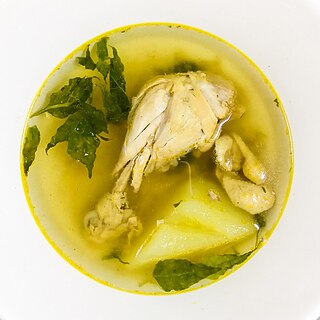
Tinola is a Filipino soup usually served as a main entrée with white rice. Traditionally, this dish is cooked with chicken or fish, wedges of papaya, and leaves of the siling labuyo chili pepper in broth flavored with ginger, onions and fish sauce.

Peranakan cuisine or Nyonya cuisine comes from the Peranakans, descendants of early Chinese migrants who settled in Penang, Malacca, Singapore and Indonesia, inter-marrying with local Malays. In Baba Malay, a female Peranakan is known as a nonya, and a male Peranakan is known as a baba. The cuisine combines Chinese, Malay, Javanese, South Indian, and other influences.
The Aklanon people are the ethnolinguistic group who lived in the province of Aklan. They are part of the wider Bisaya ethnolinguistic group, who constitute the largest Filipino ethnolinguistic group.

Ginataan, alternatively spelled guinataan, is a Filipino term which refers to food cooked with gatâ. Literally translated, ginataan means "done with coconut milk". Due to the general nature of the term, it can refer to a number of different dishes, each called ginataan, but distinct from one another.
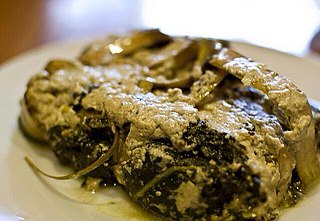
Laing, is a Filipino dish of shredded or whole taro leaves with meat or seafood cooked in thick coconut milk spiced with labuyo chili, lemongrass, garlic, shallots, ginger, and shrimp paste. It originates from the Bicol Region, where it is known simply as pinangat. Laing is also a type of ginataan, and thus may also be referred to as ginataang laing. Laing is commonly eaten as a vegetable side to complement meat or fish side dishes known as ulam in Filipino, which is normally paired with boiled white rice.
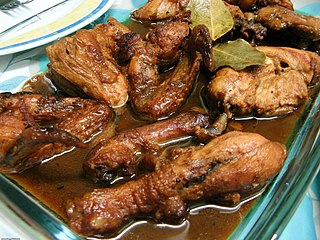
Philippine adobo is a popular Filipino dish and cooking process in Philippine cuisine that involves meat, seafood, or vegetables marinated in vinegar, soy sauce, garlic, bay leaves, and black peppercorns, which is browned in oil, and simmered in the marinade. It has occasionally been considered the unofficial national dish in the Philippines.

Inihaw, also known as sinugba or inasal, are various types of grilled or pit-roasted barbecue dishes from the Philippines. They are usually made from pork or chicken and are served on bamboo skewers or in small cubes with a soy sauce and vinegar-based dip. The term can also refer to any meat or seafood dish cooked and served in a similar way. Inihaw are commonly sold as street food and are eaten with white rice or rice cooked in coconut leaves (pusô). Inihaw is sometimes referred to as Filipino barbecue or (informally) Pinoy BBQ.
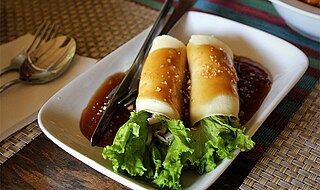
Lumpia are various types of spring rolls commonly found in the Philippines and Indonesia. Lumpia are made of thin paper-like or crepe-like pastry skin called "lumpia wrapper" enveloping savory or sweet fillings. It is often served as an appetizer or snack, and might be served deep fried or fresh (unfried). Lumpia are Filipino and Indonesian adaptations of the Fujianese and Teochew popiah, which was created during the 17th century in the former Spanish colonial era.

Lumpiang ubod, also known as heart of palm spring rolls, is a Filipino appetizer consisting of julienned ubod with various meat and vegetables in a thin egg crêpe. It is commonly served fresh, but it can also be deep-fried. It originates from the city of Silay in Negros Occidental where an original variant, lumpiang Silay, is still popular.

Afritada is a Philippine dish consisting of chicken, beef, or pork braised in tomato sauce with carrots, potatoes, and red and green bell peppers. It is served on white rice and is a common everyday Filipino meal. It can also be used to cook seafood.

Pininyahang manok, commonly anglicized as pineapple chicken, is a Philippine dish consisting of chicken braised in a milk or coconut milk-based sauce with pineapples, carrots, potatoes, and bell peppers. Some variants of the dish use a chicken stock base instead of milk. The dish originates from Southern Luzon which was once a regional center of pineapple fiber production in the Spanish Philippines.
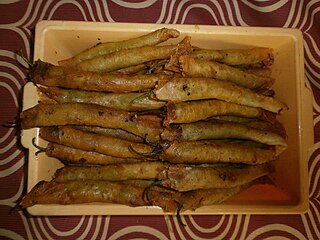
Dinamita is a deep-fried Filipino snack consisting of stuffed siling haba wrapped in a thin egg crêpe. The stuffing is usually giniling, cheese, or a combination of both but it can also be adapted to use a wide variety of ingredients, including tocino, ham, bacon, tuna, and shredded chicken. Dinamita is also known as dynamite lumpia, among other names. It is a type of lumpia and it is commonly eaten as an appetizer or as a companion to beer.

Ginataang langka, is a Filipino vegetable stew made from unripe jackfruit in coconut milk and spices. The dish includes a wide variety of secondary ingredients like seafood, meat, and other vegetables. The dish also commonly adds bagoong alamang and may be spiced with chilis or soured with vinegar. Notable variants of the dish are ginataang kamansi and ginataang rimas which use breadnut and breadfruit, respectively. Ginataang langka is a type of ginataan.
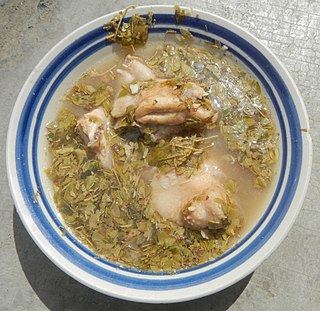
Sinampalukan, also known as sinampalukang manók or tamarind chicken, is a Filipino chicken soup consisting of chicken cooked in a sour broth with tamarind, tamarind leaves, ginger, onion, garlic, and other vegetables.

Ginataang manok is a Filipino chicken soup made from chicken in coconut milk with green papaya and other vegetables, garlic, ginger, onion, patis or bagoong alamang, and salt and pepper. It is a type of ginataan. A common variant of the dish adds curry powder or non-native Indian spices and is known as Filipino chicken curry.
Binakol, also spelled binakoe, is a Filipino chicken soup made from chicken cooked in coconut water with grated coconut, green papaya, leafy vegetables, garlic, onion, ginger, lemongrass, and patis. It can also be spiced with chilis. Binakol can also be cooked with other kinds of meat or seafood. It was traditionally cooked inside bamboo tubes or directly on halved coconut shells. The dish originates from the Western Visayas, particularly the province of Aklan.
Kadyos, baboy, kag lanka, commonly shortened to KBL, is a Filipino pork soup or stew originating from the Hiligaynon people of the Western Visayas islands. The name of the dish means "pigeon peas, pork, and jackfruit"; the three main ingredients. The soup is also traditionally soured with batuan fruits. Other souring agents like tamarind can also be used. Other ingredients include leafy greens, lemongrass, fish sauce, onions, and siling haba peppers. The pork cut used is typically the hock (pata). The dish is characteristically purple in color due to the use of pigeon peas. It is similar to another Hiligaynon dish known as kadyos, manok, kag ubad which uses chicken and banana pith instead.
Kadyos, manok, kag ubad, commonly shortened to KMU, is a Filipino chicken soup or stew originating from the Hiligaynon people of the Western Visayas islands. The name of the dish means "pigeon peas, chicken, and banana pith"; the three main ingredients. It is similar to another Hiligayon dish, Kadyos, baboy, kag langka ("KBL"), except that it does not use a souring agent, and it uses chicken and banana pith instead. Like KBL, KMU is also characteristically purple in color due to the use of pigeon peas. Other ingredients include onions, lemongrass, thinly-sliced ginger, siling haba pepper, and salt and pepper.
References
- ↑ Malvar, Martha Angela. "Binacol at Inubaran, Treasured Dishes of Aklanons, Namit Ah!". Mama Sita's. Retrieved June 6, 2019.
- ↑ "Inubaran na Manok sa Gata". Mama's Guide Recipes. Retrieved June 6, 2019.
- ↑ Morales, Hannah Reyes; Nillasca, Cecilia. "Recipe: Inubarang Manok". Anthony Bourdain: Parts Unknown.
- 1 2 "Inubarang Manok (Coconut-simmered Chicken)". My Bay Kitchen. Retrieved June 6, 2019.
- ↑ Polistico, Edgie (2017). Philippine Food, Cooking, & Dining Dictionary. Anvil Publishing, Inc. ISBN 9786214200870.
- ↑ "Going local: 6 Aklanon food you should try". Langyaw. Retrieved June 6, 2019.
